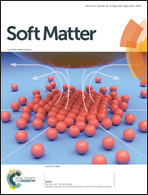A novel pillar[5]arene-based supramolecular organic framework gel to achieve an ultrasensitive response by introducing the competition of cation⋯π and π⋯π interactions†
Abstract
Ultrasensitive response properties are an intriguing concern for stimuli-responsive materials. Herein, we report a novel method to achieve an ultrasensitive response by introducing the competition of cation⋯π and π⋯π interactions into a pillar[5]arene-based supramolecular organic framework (SOF-AMP). SOF-AMP was constructed with a novel bis-naphthalimide functionalized pillar[5]arene, which was able to form a stable supramolecular gel (SOF-AMP-G) in cyclohexanol. Interestingly, SOF-AMP-G shows an ultrasensitive response to Fe3+ through the competition of cation⋯π and π⋯π interactions. Meanwhile, the Fe3+ coordinated SOF (MSOF-Fe) shows an ultrasensitive response to H2PO4−. SOF-AMP-G displayed yellow fluorescence whereas, after the addition of 0.5 equiv. of Fe3+ to SOF-AMP-G, the yellow fluorescence was quenched. The detection limit of SOF-AMP-G for Fe3+ is 7.54 × 10−9 M. More interestingly, the Fe3+ coordinated SOF gel (MSOF-Fe-G) could sense H2PO4− with a fluorescence “turn-on”. The detection limit of MSOF-Fe-G for H2PO4− is 4.21 × 10−9 M. Simultaneously, the Fe3+ and H2PO4− responsive thin films based on these SOF gels were prepared. Moreover, these SOF gels could be used as ultrasensitive ion sensors, fluorescent display materials and sensitive logic gates.
![Graphical abstract: A novel pillar[5]arene-based supramolecular organic framework gel to achieve an ultrasensitive response by introducing the competition of cation⋯π and π⋯π interactions](/en/Image/Get?imageInfo.ImageType=GA&imageInfo.ImageIdentifier.ManuscriptID=C8SM00426A&imageInfo.ImageIdentifier.Year=2018)


 Please wait while we load your content...
Please wait while we load your content...